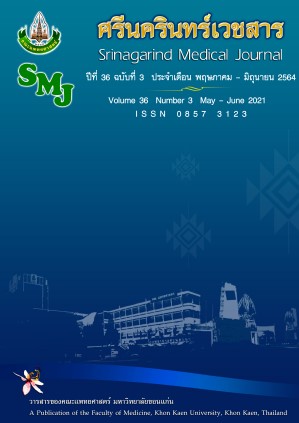A Protocol for Morphine Subcutaneous Administration at Home in dying patient
Keywords:
Morphine injection; Morphine subcutaneous administration at home; Palliative careAbstract
Background and Objectives: Palliative care in Thailand is still in an early integration into the national health care system. Morphine availability is an essential component in quality palliative care.
The objective of this study is to develop a strict protocol for using morphine injection via syringe driver in dying patients at their home.
Methods: This protocol was developed after joint meetings with hospital pharmacists. Palliative care doctors are the only doctors to prescribe morphine injections to be used at home. Patients who require morphine injections at home will be visited by Karunruk Palliative Care Center (KPC) team or by the community nurses near their home. The amount of morphine injection allowed per prescription is 3-7 days dosage. The community nurses will prepare the medication in a syringe according to the order from KPC, and the family will connect it via a syringe driver. The community nurses who prepare the medication record the exact amount of morphine injection used and sign daily in the booklet provided by KPC. When the patient dies, the family will return the syringe driver and the unused morphine injections to KPC. The palliative care nurse will validate and record the number of used and unused morphine ampules and return them to the hospital pharmacists. This protocol was introduced to all the hospitals in Health Service Area 7.
Results: The results of the study revealed as following:Have obtained syringe drivers to be used at home and percentage of morphine injections to be used in the patients’ home are 30.52, 34.85, 42.49 and 11.19 (sort by 2015-2018). After 3 years of protocol implementation coupled with intensive health professional education by KPC, now 76.1% of the hospitals in Health Service Area 7 have obtained syringe drivers to be used at home and 98.5% of these hospitals have changed their policies to allow morphine injections to be used in the patients’ home.
Conclusion: This protocol created confidence for the health care providers and enables morphine injection to be used at home in dying patients. The number of palliative care patients of Karunrak Center reduces morphine injections at home because the network has adopted this protocol more.
References
2. ทัศนีย์ ทองประทีป.พยาบาล: เพื่อนร่วมทุกข์ผู้ป่วยระยะสุดท้าย. กรุงเทพฯ: วี. พริ้น,2553.
3. ปาริชาติ เพียสุพรรณ์.คู่มือการให้ยาทางใต้ผิวหนังในผู้ป่วยระยะท้ายสำหรับทีมสุขภาพ.ขอนแก่น: ห.จ.ก.โรงพิมพ์คลัง นานาวิทยา,2558.
4. สำนักงานคณะกรรมการกฤษฎีกา.พระราชบัญญัติยาเสพติดให้โทษ2522.สืบค้นจาก: http://www.phmc.coj.go.th/doc/data/phmc/phmc_1510039791.pdf [วันที่ 23 ธันวาคม 2561],2560.
5. Healy, s., Israel, F., Reymond, E., Lyons-Micic, M. Caring safety at home palliative care for education for caregivers. Subcutaneous Medications and palliative care: A guide for caregivers. Queensland: The Australian Government Department of health and Ageing,2011.




